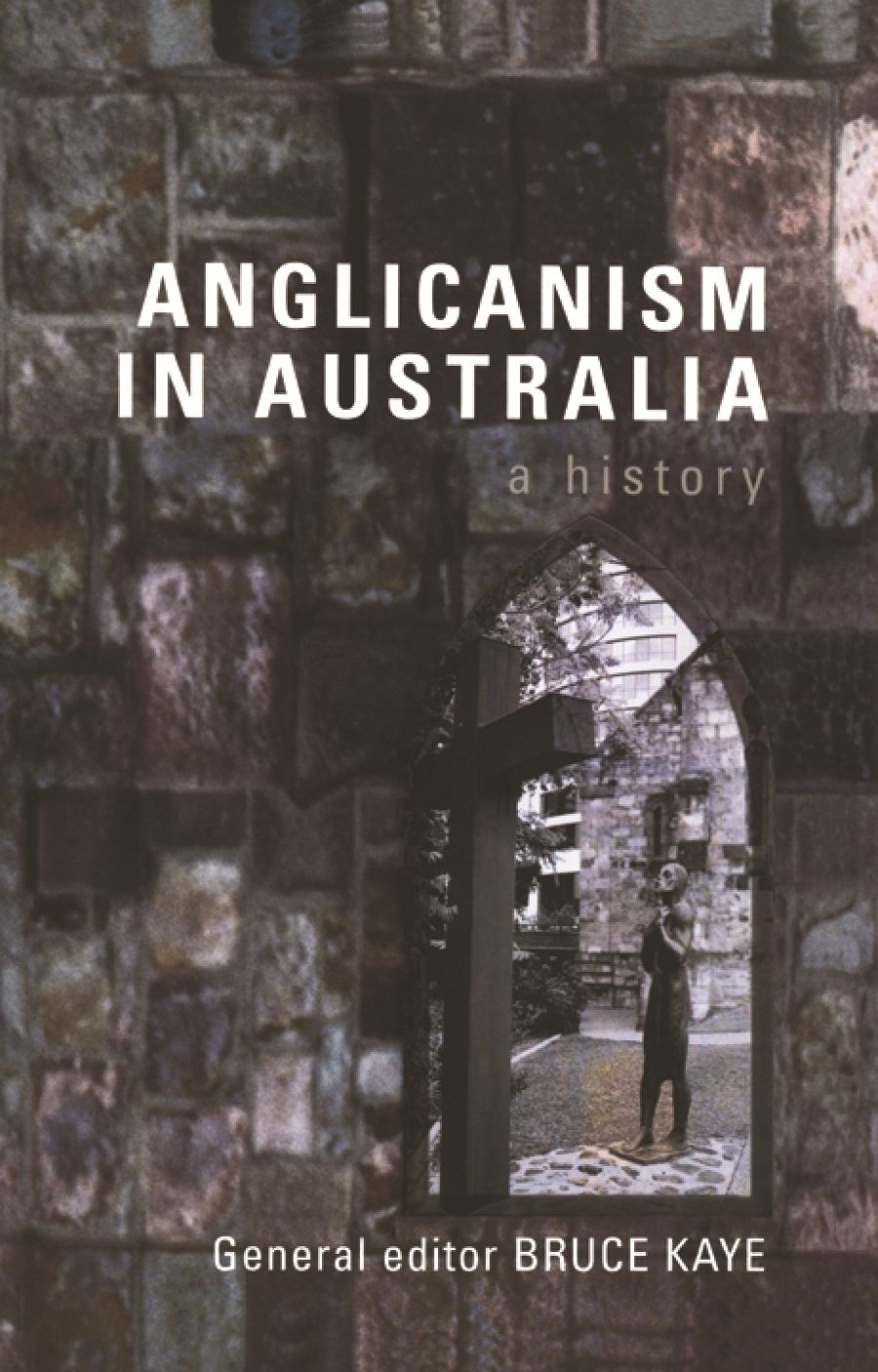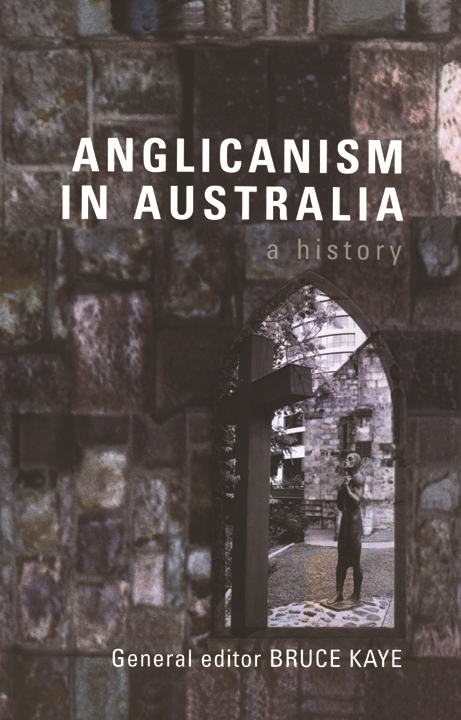
- Free Article: No
- Contents Category: Religion
- Review Article: Yes
- Article Title: Not Angels but Anglicans
- Online Only: No
- Custom Highlight Text:
When the appointment of Archbishop Hollingworth as governor-general was announced last year, some critics argued that the separation of church and state was placed at risk. This objection was not heard when Pastor Doug Nicholls was appointed governor of South Australia in 1976, nor when Davis McCaughey, a Uniting Church minister, became governor of Victoria in 1986. Was the governor-generalship of Australia seen as being in a league of its own, or did the title ‘Archbishop’ ring alarm bells? And when the new governor-general became embroiled in the controversy over the church’s response to cases of child abuse, this secularist undercurrent bubbled to the surface again. I was struck by the strain of virulent anti-clericalism that ran through much of the talk-back commentary. Somehow the Anglican Church seemed easily identified in the popular imagination as part of the Establishment – remote, authoritarian and out of date.
- Book 1 Title: Anglicanism in Australia
- Book 1 Subtitle: A History
- Book 1 Biblio: MUP, $69.95 hb, 431 pp
- Book 1 Cover Small (400 x 600):

- Book 1 Cover (800 x 1200):

Unfortunately, the slow publishing schedule of a university press did not allow the authors of Anglicanism in Australia to reflect on the Hollingworth affair, but the book is nevertheless conditioned by a sensitivity to the upper-middle-class Establishment associations of the Church. Whether the Church of England was ever technically the established church in the penal colony of New South Wales is a matter for dispute, but, as Bryan Fletcher readily concedes, it existed ‘before the 1820s as the arm of a government that provided financial backing and practical support’. This exclusive relationship between church and state could hardly survive in colonies with large Roman Catholic and non-conformist communities, but the Church of England remained close to the Establishment presided over by the colonial governors. Nor could it help but be seen as ‘the church of the British Empire’. It was not until 1981 that the title ‘Church of England’ finally gave way to the ‘Anglican Church of Australia’.
But, as this book conscientiously explores, there is another side to the story. For most of Australia’s European history, the Church of England has been the largest denomination. In 1841 its adherents represented sixty per cent of the population; in 1901 the numbers were still close to forty per cent. The two oldest colonies, New South Wales and Tasmania, had the highest proportions of Anglicans, while the church was weakest in South Australia and Victoria. In regularity of church attendance, Anglicans compared poorly with Catholics and Methodists, but the denominational attachment retained a significance as part of their cultural heritage. And it is notable that in the 1850s, when democratic ideas were transforming colonial politics, bishops conceded the need for the laity to be involved in the government of the church through the introduction of synods, which were probably the first such bodies in the Anglican world. Fletcher quotes Hans Mol’s assessment (made in 1985) that the Anglican Church, with its spread of membership across all social classes, ‘represented the population at large more than any other denomination’. Ironically, Mol was writing at about the time when Anglicans were overtaken by Roman Catholics as the largest denomination.
Unlike the Roman Catholic Church, the Church of England in Australia could never be seen as a monolith, and one of the central themes of Anglicanism in Australia is the dominance of regionalism and the continuing resistance to central authority. In the early days, this was dictated by geography. As Brian Dickey puts it: ‘diocesanism was driven by the realities of dispersed regional growth.’ In the twentieth century, however, the suspicion of centralism owed more to the hardening of party lines, particularly as the conservative evangelical diocese of Sydney grew more defensive of its position in a church increasingly influenced by Anglo-Catholicism on the one hand and liberal modernism on the other. In an essay on ‘Australian Anglicanism in a World-wide Context’, Stuart Piggin grimly notes that, although ‘it is commonly said to be a distinguishing feature of Anglicanism that it cherishes, even celebrates diversity and differences ... this stereotype does not hold true for Australian Anglicanism’.
Sydney has come to be regarded as a world unto itself and something of a phenomenon in the Anglican communion: it also happens to be the wealthiest diocese in the land. And Sydney’s fundamentalism is not without its appeal. David Hilliard reports that its evangelical parishes ‘were generally more effective than others in retaining the children of their members and in attracting people with no church background’. Nevertheless, it was possible for conservative evangelicals to join forces with extreme Anglo-Catholics to resist and delay the introduction of women priests. Even then, the General Synod, which has no power to impose its will on the church, legislated to allow each diocese to make its own decision on the ordination of women. The contributors to Anglicanism in Australia do their best to put the Sydney brand of evangelicalism in historical context and to be judicious in their treatment of church politics, but sometimes the strain of doing so is evident.
The book is sensibly organised in two parts: six narrative chapters take us from 1788 to the present day, while another seven explore particular themes, ranging from Bruce Kaye on Anglican identity to Anne O’Brien on gender issues. Colin Holden provides something of a respite from more conventional controversies with an interesting discussion of the church’s use of architecture and the visual arts, firmly locating it in the wider culture. Two chapters of particular interest are contributed by Bill Lawton on Anglican theology and John Harris on the church and indigenous peoples. ‘Anglicanism is a church in dialogue with itself,’ Lawton tells us, but he is very conscious that the wider community may be both baffled and alienated by this preoccupation. And if evangelical Sydney is ultimately the problem for Lawton, his analysis of its conservative theology treats it with great respect; he is clearly fascinated by Broughton Knox, one of its principal exponents, who first stirred his own interest in theology. The full implication of Knox’s theology emerges in his pronouncement that ‘the teaching and actions of Jesus nowhere show a concern for “social justice” ... Compassion, not social justice, is the motivation for Christian social action.’ This view seems consistent with the political conservatism of another Sydney ideologue, John Howard.
Harris struggles valiantly to present a balanced account of the church’s dealings with Aborigines and Torres Strait Islanders. He does not spare us the crasser examples of European arrogance. Samuel Marsden, for example, condemned Aboriginal peoples for ‘having no wants’, seeing this lack of materialism as obstructing the gospel. The failure of missionaries to interest themselves in Aboriginal languages is startling: according to Harris, the Bible was first read in an Aboriginal language in an Anglican church as late as 1936. On the other hand, missions offered Aborigines some protection from the violence of the frontier and contributed to their survival. From the 1930s the mission organisations were sympathetic to Aboriginal political activists, though it was some time before they were prepared publicly to criticise government policies.
Lawton refers to the widespread perception of Anglicanism as ‘a religion of moderation’. There is, perhaps, something ‘moderate’ about the tone of this book, as its authors take care to present a rounded, warts-and-all history of the church in Australia. Yet beneath the unimpassioned prose and the measured judgments, one recognises the ambiguous loyalties of committed Anglicans. Growing up as an Anglican in Sydney, my own memories range from books with sepia photographs of the great English cathedrals, to the Sunday eloquence of the Book of Common Prayer and the hushed reverence of the daily choral Evensong broadcast by the ABC from one of our local cathedrals (‘O Lord, open thou our lips’). The Anglican Church has changed considerably since then and, for all its quirks and disabilities, has shown a preparedness to address issues such as the ministry of women and the acceptance of homosexuality. It would be a pity if it were only Anglicans who were to read this book, for it has much to tell us about religion and Australian society.


Comments powered by CComment